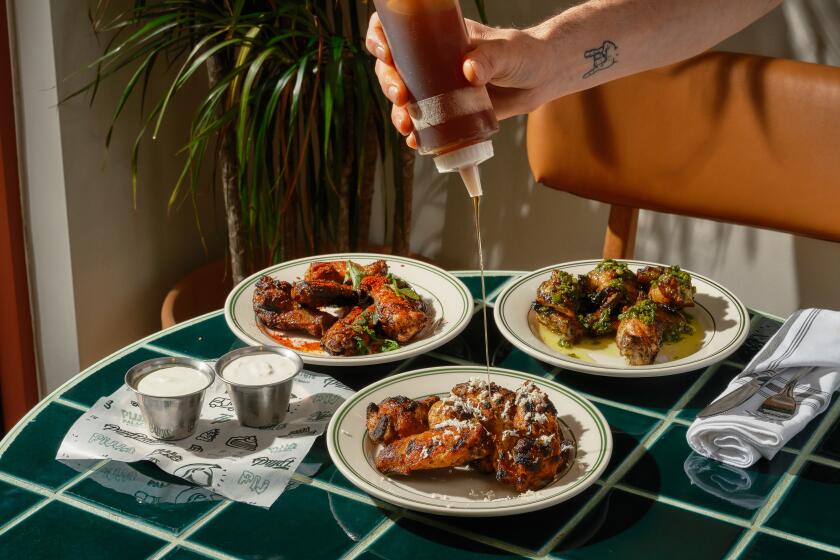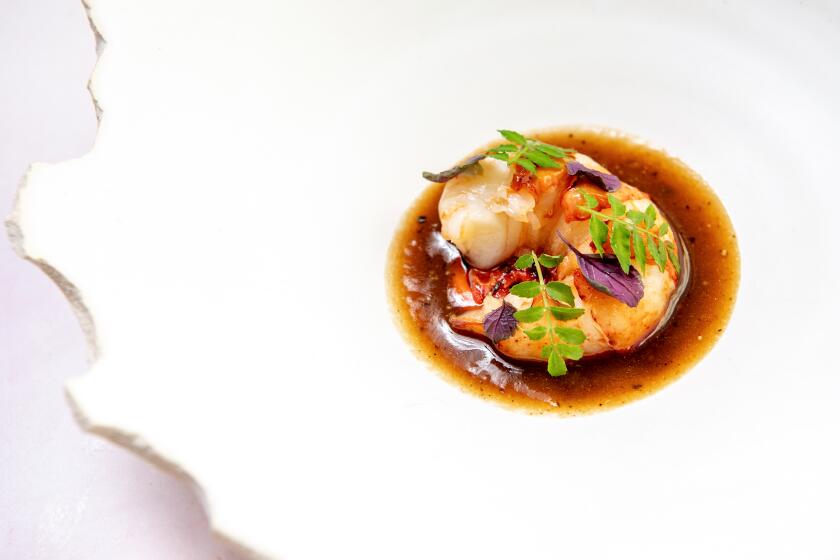A new understanding of your childhood cliche - sweet and sour pork
Sea Harbour is one of the two or three best Hong Kong-style restaurants in the Los Angeles area, a comfortable dining room with impeccable live seafood and deft interpretations of Chinese luxury dishes. If you were looking for bird’s nest, braised sea cucumber or sun-dried abalone preparations, I would recommend the restaurant without hesitation. It also serves some of the best dim sum in the area, not quite at the level of the very best places in Vancouver, perhaps, but very, very good. Its rear dining room is lined with signed photographs from the Hong Kong singers and movie stars who frequent the place when they are in Los Angeles. It is the closest thing in the San Gabriel Valley to a safe bet.
I had looked forward to visiting the restaurant for dim sum last week with three of Hong Kong’s best-regarded chefs: Kam-fu Cheng from the two-star Cantonese restaurant Celebrity Cuisine; Mango Tsang from two-star Ming Court in Langham Place, and dim sum master Kwai-pui Mak, who left the three-star kitchens of the Four Seasons to open Tim Wo Han, often called the cheapest Michelin-starred restaurant in the world.
I assumed the chefs would have special insight into the kitchen’s strengths, the skill of its cooks, and also the compromises that often have to be made when a restaurant is 7,200 miles from the heartland of its cuisine. I also assumed that they would perhaps illuminate corners of the menu that I hadn’t discovered in the course of two dozen visits, odd specialties or regional cooking methods that might take a real expert of the cuisine to suss out—such dishes must exist even on the dim sum menu.
When I showed up to the restaurant, finding the chefs already seated around a huge round table with their sous chefs and officials from the Hong Kong tourism board, they had already ordered, and were studying a large platter of what appeared to be not dumplings but sweet and sour pork – a dish we have been told for years not to order in elegant Chinese restaurants because it is a cliché, an item kept on menus only for the convenience of non-Chinese who might not know any other dish. Sweet and sour pork is the dish a waiter suggests after he has plunked down the forks and the cruet of soy sauce. It couldn’t be sweet and sour pork.
“This is sweet and sour pork,” said Cheng through an interpreter.
“It is a dish we often request when we wish to take the measure of a kitchen,” Tsang explained. “It’s not just a dish for Chinatown - sweet and sour pork reveals much about a cook’s level of skill.”
“Has the pork been properly marinated?” Tsang continued. “Is it evenly coated with just enough cornstarch – neither too much, which would be unpleasant, nor too little, which would leave the texture uneven? Has it been deep-fried at the proper temperature, and for the proper amount of time? It must be crisp and thoroughly cooked, but still juicy, and not the slightest bit burnt. This is difficult.”
“In the second stage of the recipe, is the pork stir-fried in a manner that coats it completely with the sauce but does not allow soggy spots to form? Is the fragrance balanced and pleasant? Is the sauce slightly reduced, somewhat caramelized? Do the slices of pork remain separate, or are they allowed to clump together? Are the vegetables well-cut? It is a simple preparation, but…”
“There is only one recipe,” Cheng says. “Excellence lies in the cook’s execution, not in his creativity.”
“Some variation is possible,” Tsang says. “One cook may dilute the vinegar with pineapple juice; another may include more plum sauce than ketchup. But yes – basically the same recipe.”
I spooned a bit of the pork onto my plate and took a tentative bite. It was more crunchy than fleshy and slightly less chewy than I had expected. The glossy, pinkish sauce covered the pork as evenly as if the meat had been electroplated. It wasn’t quite as sweet as what you might find at Panda Express, although it wasn’t much less sweet either, and there was a faint but distinct aftertaste of plum. It was sweet and sour pork.
“How does this rate?” I asked.
Tsang was silent for a moment. “It is better than you’ll find even at some restaurants in Hong Kong.”
Also:
Jonathan Gold’s favorite baja tacos
The chefs from Hong Kong want dim sum
Best Mexican restaurants, according to Mr. Gold
More to Read
Eat your way across L.A.
Get our weekly Tasting Notes newsletter for reviews, news and more.
You may occasionally receive promotional content from the Los Angeles Times.






